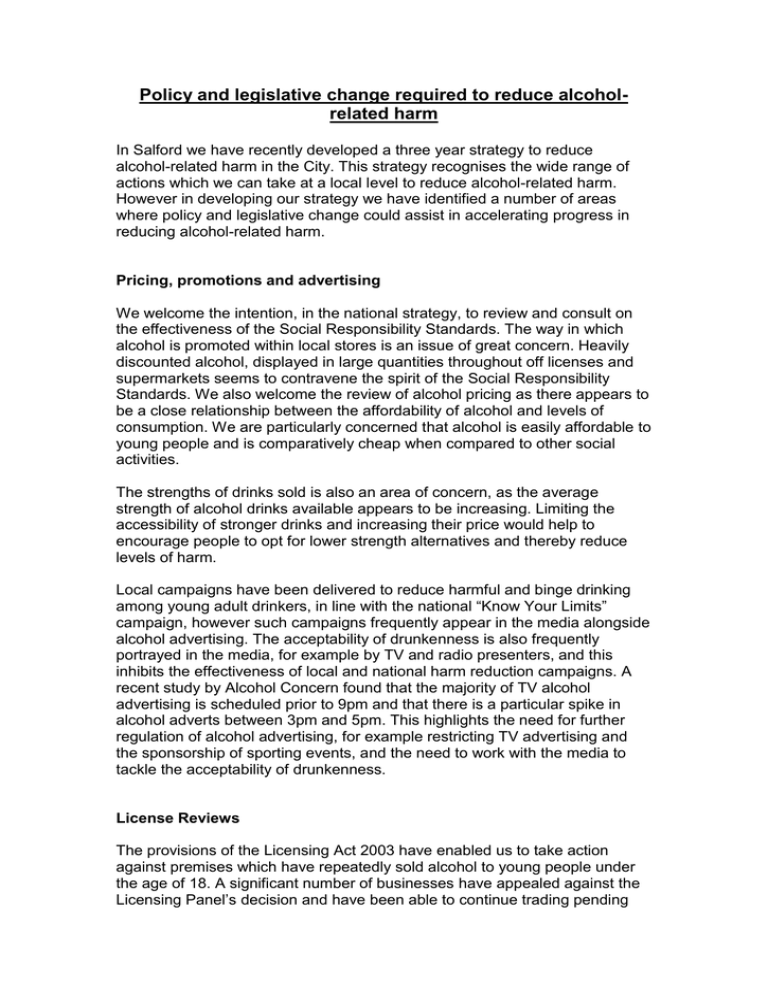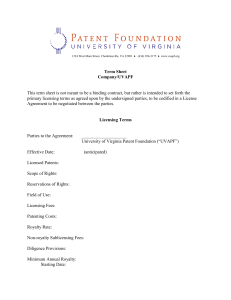Policy and legislative change required to reduce alcohol- related harm
advertisement

Policy and legislative change required to reduce alcoholrelated harm In Salford we have recently developed a three year strategy to reduce alcohol-related harm in the City. This strategy recognises the wide range of actions which we can take at a local level to reduce alcohol-related harm. However in developing our strategy we have identified a number of areas where policy and legislative change could assist in accelerating progress in reducing alcohol-related harm. Pricing, promotions and advertising We welcome the intention, in the national strategy, to review and consult on the effectiveness of the Social Responsibility Standards. The way in which alcohol is promoted within local stores is an issue of great concern. Heavily discounted alcohol, displayed in large quantities throughout off licenses and supermarkets seems to contravene the spirit of the Social Responsibility Standards. We also welcome the review of alcohol pricing as there appears to be a close relationship between the affordability of alcohol and levels of consumption. We are particularly concerned that alcohol is easily affordable to young people and is comparatively cheap when compared to other social activities. The strengths of drinks sold is also an area of concern, as the average strength of alcohol drinks available appears to be increasing. Limiting the accessibility of stronger drinks and increasing their price would help to encourage people to opt for lower strength alternatives and thereby reduce levels of harm. Local campaigns have been delivered to reduce harmful and binge drinking among young adult drinkers, in line with the national “Know Your Limits” campaign, however such campaigns frequently appear in the media alongside alcohol advertising. The acceptability of drunkenness is also frequently portrayed in the media, for example by TV and radio presenters, and this inhibits the effectiveness of local and national harm reduction campaigns. A recent study by Alcohol Concern found that the majority of TV alcohol advertising is scheduled prior to 9pm and that there is a particular spike in alcohol adverts between 3pm and 5pm. This highlights the need for further regulation of alcohol advertising, for example restricting TV advertising and the sponsorship of sporting events, and the need to work with the media to tackle the acceptability of drunkenness. License Reviews The provisions of the Licensing Act 2003 have enabled us to take action against premises which have repeatedly sold alcohol to young people under the age of 18. A significant number of businesses have appealed against the Licensing Panel’s decision and have been able to continue trading pending their appeal being heard. This potentially places the public at risk, as where premises are reviewed it is because they have repeatedly breached their license conditions. We would support a change in the law to ensure that licensing panel decisions can be put into place with immediate effect rather than having to wait for the outcome of an appeal. If an appeal is successful these conditions can then be lifted. Training for licensees In order to support licensees to comply with the Licensing Act and retail alcohol responsibly we have provided accredited training in responsible alcohol retailing and conflict management. However the numbers that we are able to engage are limited when attending this training is optional. Ensuring that licensees are well informed and have the skills and knowledge to manage their premises in a responsible way is essential if we are to reduce alcohol related harm. We therefore believe that training in how to reduce the risk of harm and meet the requirements of the Licensing Act should be compulsory for all personal license holders in on and off licensed premises. Investment in alcohol services Securing investment in order to effectively deliver the local alcohol strategy is an ongoing problem. In recent years the lack of an alcohol specific target in performance management frameworks has made securing investment difficult, therefore the introduction of an alcohol indicator in the form of National Indicator 39, is very welcome. However the many years of lack of investment have resulted in alcohol treatment services not having sufficient capacity to meet the needs of alcohol users in their local population. The Department of Health’s Alcohol Needs Assessment Research Project calculated Prevalence Service Utilisation Ratios for each region of England. This varied from 1 in 12 alcohol dependent people accessing treatment in the North West, to 1 in 102 in the North East (2005: 21). In North America an access level of 1 in 10 is regarded as a low level of access, 1 in 7.5 medium and 1 in 5 high. A substantial increase in investment is needed if Prevalence Service Utilisation Ratios are to be brought into line with North American standards of access. In addition lack of funding also restricts our ability to deliver effective harm reduction and prevention campaigns or to further increase our level of activity in enforcing the Licensing Act and regulating the sale of alcohol. For example, whilst it is a statutory duty on local authorities to enforce the provisions of the Licensing Act 2003 which relate to underage sales of alcohol, no funding has been made available to undertake this work. The Home Office funding which was provided for the AMEC and last year's TUSAC campaigns only covered the cost of the test purchasing exercise. It did not cover the cost of investigations, prosecutions or reviews of licences. Whilst we can incorporate some of this work into our mainstream activity we have endeavoured to be extremely proactive in tackling this problem, with approximately 16 License reviews taking place over the past year. If this level of work is to be sustained then a modest amount of funding needs be made available to support the cost of investigations, prosecutions and reviews. The specific funding which has been made available to support other national strategies such as drugs and teenage pregnancy, has helped to drive these strategies forward and has ensured that significant investment is made to improve services. Such ring-fenced funding is also needed to support the alcohol strategy if it is to be fully implemented in every area, particularly in relation to reducing hazardous, harmful and binge drinking, and improving services for dependent drinkers.



